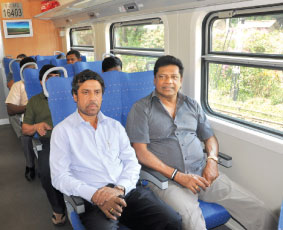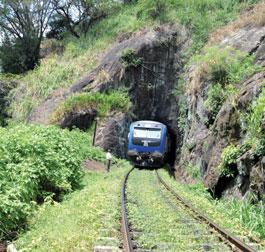Govt to improve train services
By Gamini Warushamana
The Ministry of Transport and the Sri Lanka Railway (CGR) has
launched a medium- term development program from 2012-2015 to improve
the railway service to meet the needs of the economy, said the General
Manager, CGR, B.A.P. Ariyaratne.
 |
|
Pix: Susantha
Wijegunasekera |
"In the CGR we have a general development plan with an annual budget
including plans to maintain and upgrade the fleet of trains, railway
lines and the signal system.
However, these are not in a combined overall plan and under this
medium-term plan we have combined them considering all aspects of the
service and there are several new projects. We have already implemented
some of the proposals in the program," he said.
Under this medium-term plan, the signal system, tracks and fleet will
be improved. The present signal system on the main track is over
50-years-old and causes problems in the smooth functioning of the train
service. He attributed train delays due to the aged signal systems as
being the main reason for train delays.
Construction of another track in the Southern railway line and
construction of the third track between Colombo and Panadura is another
proposal under this program. The limitation of the track creates heavy
traffic congestion which in turn contributes to train delays.
For instance there are seven trains within 35 minutes in the mornings
from Panadura to Colombo or a train every five minutes. Also the third
track on the upcountry railway line which now runs up to Ragama will be
extended to Polgahawela.
The development of the Kelani Valley railway line cannot be started
due to unauthorised construction along the line. There are 1,180
families living in lands belonging to the CGR in this area and due to
this, even running trains on this line is difficult today. Under the
medium-term development plan it is proposed to evacuate these families
by providing them alternative houses and developing the Kelani Valley
line with two tracks up to Padukka. Investment for this project is
expected from a Chinese government institution.
 |
|
Transport minister Kumara Welgama and
General Manager, CGR, B.A.P. Ariyaratne. |
 The CGR celebrates 150 years in 2014 and parallel to this a railway
museum will be set up in Kadugannawa. A credit line from the Chinese
government is expected to complete the railway museum. The CGR celebrates 150 years in 2014 and parallel to this a railway
museum will be set up in Kadugannawa. A credit line from the Chinese
government is expected to complete the railway museum.
Ariyaratne said that the introduction of a convenient ticketing
system is another proposal in the medium-term development program. The
existing ticketing system is costly and inefficient is the view of
passengers and the management. Counting revenue and accounting is
difficult with this manual system and the CGR loses millions in revenue
as a result. This year the CGR has earned over Rs. 9 m in fines from
fair dodgers.
Improving facilities at railway stations is another aspect of the
development program. At present, most of railway stations are in a bad
state and even basic facilities are not available for passengers.
Meanwhile, since the length and height of platforms in some stations
are not sufficient to accommodate the new trains, reconstruction work of
the platforms has already begun.
The development plan will also focus on increasing revenue by
efficient rent collection from CGR-owned lands and buildings that have
been rented out and by increasing cargo transportation. Last year, the
rent income of the CGR doubled with the introduction of an efficient
collection system and expanding coverage. There are a large number of
squatters on CGR land who do not pay any rent.
"With the addition of new power- sets we now have locomotives for
cargo trains and we will start container transportation," Ariyaratne
said.
New rail tracks
In addition to reconstruction of the Northern railway line, the
Nanuoya-Nuwara Eliya-Udupussellawa line, abandoned 40 years ago, will be
developed to cater to the increasing demand with the boom in the tourism
sector.
The CGR continues to run at a loss and the revenue is sufficient to
cover half of its recurrent expenditure. The recurrent expenditure of
the CGR is between Rs.9,000-10,0000 m but the revenue is between Rs.
4,500-4,700 m.
Although revenue is increasing, the profit margin has further reduced
with the diesel price increase. Around 15 percent of the losses is due
to tickets provided to schoolchildren and government sector workers at
concessionary rates.
The quality of train services has improved significantly. Over $ 172
m has been invested in 33 new power sets.
New value added services such as luxury service compartments, online
ticket booking facilities, new office trains, increased seating capacity
in the second class have also improved the quality of the train service,
he said.
|



